
FNR-102

Land management for any purpose requires planning, time, labor, and money. An efficient and cost-effective way to manage a parcel of forest land for wildlife habitat and/or recreational objectives is through timber management. Timber management occurs in three stages: regeneration, intermediate treatments, and harvests. When preplanned, all stages can create desirable habitat components.
A number of standard practices can be employed to routinely integrate wildlife management with intermediate treatments and normal forest management operations (Table 1). These suggested management practices provide valuable wildlife habitat while serving useful timber or land management functions such as soil erosion control or seedling regeneration.
General practice Wildlife benefits Timber management
considerations
-------------------------------------------------------------------------------------------------------
Protect woodlot from livestock Provides increased mast availability, Prevents soil compaction.
grazing. greater browse availability, and thicker Improves vigor and growth
stem density for cover. rates of trees. Provides greater
regeneration and species
diversity. Reduces decay and
defects in timber.
Allow shrubs, vines, Provides food and cover for wildlife. Gradual edge reduces wind
blackberries, etc. to develop Provides early successional habitat and drying effects in woods.
along woods edge (or plant required by many species. Provides Timber quality is poor along
them). highly productive habitat (many forest edge; therefore, vines
species live at woodland edge since and undesirable species have
they require more than one habitat less economic effect.
type).
Allow felled trees to remain Provides cover. Produces insect Saves time and labor cost to
along edge of woodlot. sources for wildlife. remove. Returns nutrients to
the soil.
Plant conifers in small blocks Provides cover during harsh weather. Provides tree species diversity.
(less than 2 acres) of up to 10% Provides nesting habitat for songbirds. Prevents soil erosion.
of the area. Most efficient when Provides food for wildlife.
established on nonforested
erodible areas. One to two rows
of shrubs which provide wildlife
foods (dogwood, highbush
cranberry, crabapple,
Washington hawthorn, redbud,
etc.) can be planted adjacent to
conifer plantation.
---------------------------------------------------------------------------------------------------------------
In some cases, management may be as simple as providing protection against grazing, insects, fire, and diseases. In others, more intensive management may involve frequent cuttings and intermediate treatments which substantially alter the forest character and provide new habitat conditions favoring certain wildlife species.
Habitat components that can be created include open water, permanent openings or old fields, conifers, crop fields or food plots, shrubs or early successional habitat, fruit bearing trees, beech stands, oak stands, or den sites. Concentrate on creating some of these components when managing your woodlot. Other practices, such as leaving buffer strips of unbroken forest along streams and roads, provides a contiguous habitat. This allows travel corridors for crossing property lines. It links your property with other important wildlife habitats in surrounding areas.
Wildlife management can be facilitated by using sound timber management to provide a diversity of habitats over the entire landscape. Many timber management practices such as timber stand improvement (TSI) or commercial harvests often favor a diversity of trees capable of providing food and shelter for wildlife. Due to the relatively small size of most privately owned forested tracts, few owners have the luxury of managing timber stands which accommodate all the needs of hawks, deer, or wild turkey. Consideration must be given to the habitat components available in adjoining stands, the wildlife and timber species most suited to a given site, and the habitat needs most limited for the primary wildlife species to be featured on the property.
Conduct an inventory of the property and identify current plant and animal species. Look for unique geologic features (springs, spring seeps, caves, outcrops, streams, potholes, wetlands, etc.) or vegetative features (den trees, desirable fruit producing species, snags) which should be protected or enhanced. Developing recommendations that satisfy the landowner's various objectives and stand conditions requires a thorough management plan.
Regeneration cuts are designed to encourage seedlings and saplings to grow in the understory or in newly created openings. Young trees will be the crop trees of the future.
Encourage this regeneration by using harvest methods such as shelterwood cutting, regeneration cutting, single tree selection, or group selection cutting which allows light to reach the understory and reduce competition from undesirable species. These practices also may be followed by controlled burns, herbicide treatments, and planting of certain seedling species to get the desired results.
Some species of songbirds that migrate to the tropics in winter, certain warblers, vireos, tanagers, and thrushes (also called "neotropical migrant song-birds") may require large units of forest habitat containing a limited amount of non-forest edge. Current research suggests nesting in close proximity (300 meters) to non-forest edges may be detrimental to some woodland songbirds due to higher concentrations of predators and nest parasites. There are two types of edges; forest and non-forest edges. A non-forest edge is a distinct break between forests and non-forest covertypes such as agricultural fields, subdivisions, urban areas, and pastures. A forest edge is created when a regeneration cut or group selection cut is made. Tornadoes, high winds, and fire are natural forest edge creators. The edge is only evident for a short time (5-15 years), and then disappears as the regenerating trees grow larger. This type of disturbance provides a variety of trees in the forest of different ages, tree heights, and densities, which are needed to provide nesting, foraging, and gleaning areas for various wildlife species. In fact, nearly 70 percent of the 260 wildlife species occurring in the central hardwood forest require successional stages of a forest less than 40 years old to meet at least part of their habitat requirement.
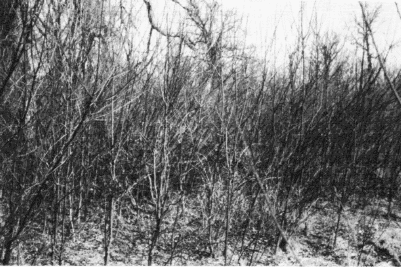
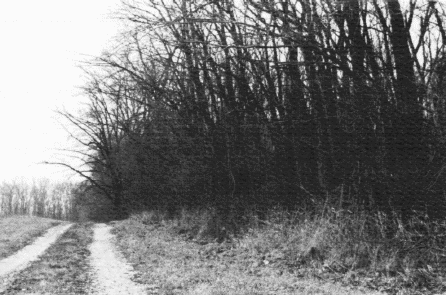
In some areas, especially near municipalities and in farming areas, the landscape has been fragmented by development and agriculture, leaving small, sometimes isolated woodlots. This situation is common in northern and central Indiana. In hilly, less arable areas, particularly in south-central Indiana, land that was previously farmed has reverted to forest cover, thus creating a more continuous forest canopy and a less fragmented landscape than in the first half of the 1900's.
It may be advantageous to manage a portion of the forest landscape in a way that minimizes non-forest edges for the wildlife species sensitive to this type of edge. Since this practice often requires large tracts of land, this may be accomplished most practically on public lands, corporate ownerships, or where several private landowners cooperate to accomplish a common management objective.
Intermediate treatments are a series of procedures designed to produce a stand of desired size and species composition. Most intermediate treatments are referred to by foresters as "timber stand improvement" (TSI). TSI can be accomplished through cull tree removal, precommercial thinning, commercial thinning, and vine removal. Most intermediate treatments provide products, including fence posts, firewood, lumber, pulpwood, pallet material, or specialty items, which can be used on the property or sold.
Cull tree removal eliminates diseased, poorly formed, or undesirable trees from the stand. Uncommon species, den trees, well-formed trees, and vigorously growing trees should be favored for both timber and wildlife management. Decisions made during the culling process will be some of the most critical ones you make concerning wildlife on your forested lands. Some tradeoffs have to be made between timber and wildlife interests, particularly when considering cavity trees (or den trees) and snags.
Cavity trees are living trees which have internal cavities. These cavities are created by injury, disease, woodpeckers, or loss of large limbs. The best cavity trees have healthy crowns, a cavity protected from rain, and may provide multiple benefits, including multiple dens and mast production, or contain woodpecker nests on large dead limbs. Because of the long time period required to produce a cavity tree, both existing and potential cavity trees with healthy crowns should be retained through any rotation to provide adequate den sites while a new stand is developing. Actively used cavities can be identified by smoothly worn entrance holes (bird nest), fresh gnawing around the entrance (mammal den), or observation of wildlife use. These should be retained, and additional trees with cavity potential may be left to achieve your objective. Cavities usually occur in tree crowns and may affect less than 20 percent of total hoard foot volume.
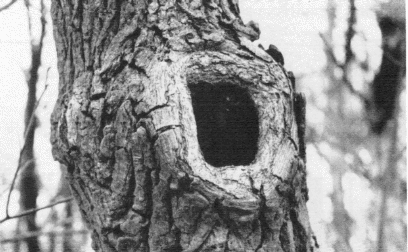
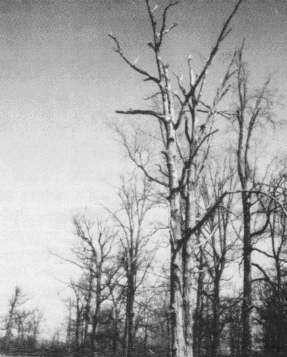
However, the retention of living cavity trees without timber value occupies growing space that could be devoted to a crop tree. But with careful selection, the best cavity trees only take a small proportion of the available growing space in the stand. Many rough cull and rotten cull trees are not good "den trees" for wildlife and may be removed from the stand.
Snags are dead trees at least 10 feet tall and at least 6 inches DBH (Diameter Breast High). They provide perches for singing, hunting, foraging, resting, and roosting, as well as foraging sites for insect-eating birds and mammals. In addition, woodpeckers, Northern flicker, Carolina chickadees, and black-capped chickadees can excavate cavities in these trees. Snags provide many of the benefits of cavity trees, such as shelter, areas for roosting, hiding, and nesting. In addition, secondary cavity users, which include many species of birds, mammals, reptiles, and amphibians, will also use these trees. Evenly distributed snags and cavity trees are needed in each habitat type (Figures 1 and 2).

Over 50 wildlife species use the cavities found in snags or living trees for shelter. Many species of cavity users have specific preferences for living or dead trees, while others will use both. Due to the variation in size of these animals (Barred owl needs 20" DBH minimum, Carolina chickadee needs 4" DBH minimum), cavities of varying diameters are needed to accommodate them. In addition, these cavity using wildlife species may have specific preferences for heavily forested, semi-open, open, bottom-land hardwood, or riparian habitats.
Since living cavity trees are more scarce than dead trees, they should be given preference when choosing trees to meet cavity objectives. Snag trees result from natural mortality and TSI operations. Thus, when selecting trees to remain as cavity trees, select species with long life spans (favor white oak species over black oak species) that attain large diameters. Also, choose trees with healthy crowns that are likely to remain in the stand for a long time. If a sufficient number of existing cavity trees are not available, select large trees which show cavity potential. Over mature trees or trees with woodpecker holes, physical damage, fungal infections, dead portions, or trees stressed by mechanical damage or disease are all good candidates. When deadening trees to create snags, only deaden trees larger than 19 inches DBH after your requirements for living trees in that size class have been met.
Approximately 90 wildlife species n the central hardwoods region depend on cavity trees and snags for food and shelter. In order to accommodate the needs of the widest variety of wildlife species, a mixture of cavity and snag trees of the proper sizes (Figures 1 and 2) should be left in each stand. For best results, these structures should occur in both openings and mature forests. The retention of snags has little effect on the growth of desirable trees. In fact, leaving these trees in the stand saves time and money often spent on removal. In addition, the insect eating bird and mammal species these snags attract play a role in controlling insect pests in your woods. In forest interiors, the retention of six snags and seven cavity trees per acre of the proper sizes is ideal. Wooded watercourses provide an important type of habitat to a more diverse set of species. Therefore, the optimum number of snags and cavity trees is higher-twenty-five snags and/or cavity trees per acre 1.
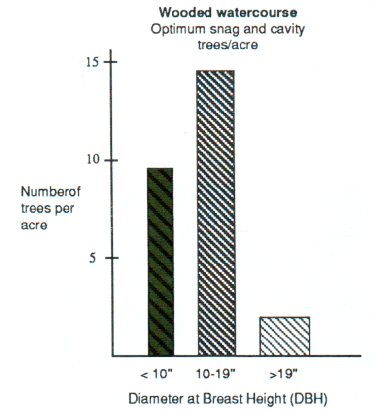
* Because less harvest activity is recommended adjacent to water courses, a distinction is not made between snags and cavity trees. It is not necessary to deaden valuable cavity trees to achieve a given number of snags.
When a tree marked for removal is not needed for firewood, fenceposts, or marketable products, girdling the tree with a chain saw and injecting the trunk with herbicide will remove the tree from competition with neighboring crop trees, save labor and time, and create snags. Avoiding deep girdling allows snags to stand longer. After the tree falls, it may serve as a drumming log for ruffed grouse. In addition, the decaying wood may provide habitat for over 65 wildlife species including salamanders, snakes, song birds, and small mammals. A fallen tree returns nutrients to the soil as it decays.
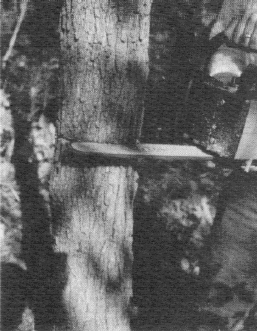
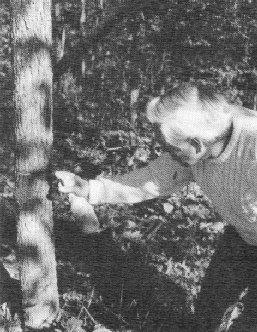
Productive, mast-producing trees such as beech, oak, hickory, walnut, cherry, or maple, should be left in areas where production of this fruit is limited. In many cases, the same tree serves dual purposes. For example, one tree can serve as a cavity tree and mast producer, a timber tree and mast producer, or a timber and cavity tree.
Thinning is designed to remove trees from an overstocked stand to allow more room for the desirable "crop trees" to grow, and reduce competition with the crop trees which already have crowns in the overstory. Forest stands benefit from a precommercial thinning when they are 20 to 50 years old. In some cases, a second commercial thinning may be recommended before the stand reaches maturity. The thinning process allows the remaining trees to maintain a rapid growth rate, and may provide some valuable products. Removed trees can provide firewood, fenceposts, small sawlogs, and other marketable products. The resulting tree tops and brush (slash) can be piled along edges, or other areas receiving heavy wildlife use, to provide cover. Piling brush on stumps, rock piles, or logs creates a space for wildlife underneath. In areas where deer use is heavy, thinnings during the winter may reduce browsing on desired seedlings by producing ample palatable browse at ground level from the resulting slash. A mixture of hard mast trees (oak, hickory, beech), soft mast trees (cherry, black gum, ash, sassafras, tulip poplar, and maple), and mast producing shrubs and small trees (dogwood, hazelnut, ironwood, and viburnum) should be available in every stand. A variety of white and red oak species should be selected in order to maintain more consistent acorn production from year to year.
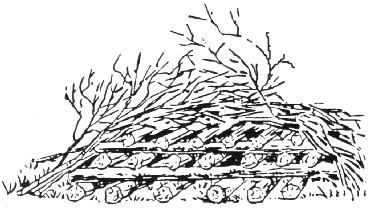
When thinning sapling stands, maintaining less than 50 percent canopy closure can be accomplished through wide spacing (greater than 10 x 10 feet) between selected crop trees. This practice encourages rapid tree crown development and a diverse understory development. Thinnings scheduled at 10 year intervals will continue to promote understory development. These thinnings can also be used to release the crowns of selected mast and den trees through the poletimber and sawtimber stages. This practice maintains valuable wildlife trees and provides improved browse and herbaceous plants around trees already selected for wildlife (see Table 2 on page 6).
There are many wildlife recommendations that can be incorporated into the harvest procedures to improve wildlife values (see Table 3 on page 7). With the exception of some songbirds, which may be sensitive to edge (discussed earlier in the text), most wildlife species found in the central hardwood forest require openings, edges, or early successional stages of forested habitat to fulfill a portion of their habitat requirements. An efficient way to manage for these species is to create their desired habitat component as a result of a commercial harvest. This makes the cost of the practice affordable, and provides an economic return to the landowner.
TSI practice Wildlife benefits Timber management
considerations
---------------------------------------------------------------------------------------------------
Retention of cavity trees can Provides den and nest sites for Some cavity trees also may be
be concentrated within 50' of wildlife. timber trees. Provides a
woods' edge (where timber diverse bird and mammal
value Is lowest), or in wetland population important to the
area, or adjacent to stream ecology of the forest (i.e.,
(where timber harvest is squirrels distribute seeds;
difficult or not recommended woodpeckers eat harmful
for water quality concerns). insects, etc.).
Girdle nonmarketable trees Creates snags which provide food Saves time and labor cost
which must be culled from sources for insect eating birds such over removal.
the stand. Inject with as woodpeckers, nuthatches, etc. Reduces damage caused by
herbicide instead of removing Creates perches for hawks. felling cull trees.
and leave existing dead trees
or snags.
Encourage mix of mast Provides food for wildlife. Provides seed source for
producing trees (red oak future tree regeneration. Many
species, white oak species mast-producing trees are
beech, hickory, walnut, valuable timber-producing
cherry, blackgum, ash, maple, species-oak, cherry, walnut,
and tulip poplar). hickory, maple, and ash.
Diversity protects against
insect and disease infestations
that can destroy single tree
species (i.e., Chestnut blight,
Dutch elm disease).
Perform no TSI or Provides mature trees for species Saves time and labor cost in
management on inoperable requiring this cover type. areas providing no economic
sites (areas where logging return.
equipment cannot reach).
----------------------------------------------------------------------------------------------------------------
Uneven-aged management is a good strategy for small acreages, or areas that are to be maintained for aesthetic quality in a continuous forest canopy. Uneven-aged management also provides a steady, periodic economic return. Single-tree selection (individual trees selected for cutting) results in stands dominated by shade tolerant species such as American beech and sugar maple. This practice is most appropriate for wildlife species such as the wood thrush, box turtle, worm-eating warbler, and broad-winged hawk who do not require openings or shade intolerant mast producing tree species. Den sites for cavity nesting species requiring mature stands with canopy closure greater than 70% (barred owls and white-breasted nuthatches) and snags supplying food for insect eaters (downy woodpecker, red-bellied woodpecker, and Carolina chickadee) should remain when selecting trees for harvest. Additional trees can be provided by TSI considerations. In order to provide mast-producing trees and shrubs within the stand, managers often combine group tree selection with single tree selection within the same forest. If this is not possible, food and structure diversity can be provided for wildlife by planting fruit producing trees and shrubs along woodlot edges and edges of log landings. Keeping the forest canopy open over logging roads (daylighting) to stimulate shrub production is another way to provide these needs. Supplemental food can be provided in food plots located along woodland edges, in log landings, or by leaving some waste grain or standing grain in adjacent fields.
Regeneration openings are created in the forest canopy to stimulate regeneration of shade intolerant mast-producing tree species, such as oak, tulip poplar, cherry, ash, etc. In small forest ownerships, this is most commonly accomplished through group selection cuts which are usually 1/2 acre in size or greater. A dense growth of tree seedlings and other woody plants will flourish in these openings. Many of the species found there, such as dogwood, serviceberry, raspberry, and viburnums, provide a diverse food source for wildlife species, and a shrubby understory structure preferred by many bird and mammal species (summer tanager, indigo bunting, cooper's hawk, sharp-shinned hawk, and rabbit). In 5 to 15 years these early successional plants will be dominated by mast producers, eventually providing acorns, cherries, and walnuts. Since these openings are constantly changing, subsequent cuts should be planned every 10 to 20 years to create a diverse forest with well-distributed, small, even-aged tree groups of various ages and species.
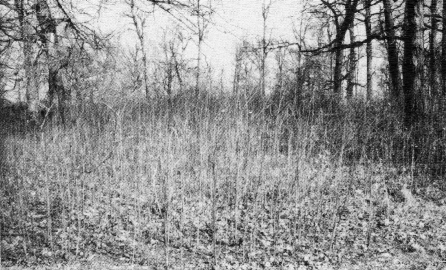
Harvest practice Wildlife benefits Timber management
considerations
-------------------------------------------------------------------------------------------------------
Design regeneration and group Provides browse, nesting. food, Regenerates shade-intolerant
selection openings with irregular and escape cover. Increases species (oak. tulip poplar. ash,
boundaries when possible. habitat interspersion. cherry, walnut). These are cost
effective harvest strategies.
With strip cuts. dear-cut timber Provides continuous supply of Regenerates shade intolerant
in strips 60-300 wide', spaced ample browse, food, nesting, and species. Provides regular
600-900' apart. Passion cuts to escape cover. Ensures economic return through
run perpendicular to the slope. availability of plants and pulpwood sales.
earthworms with varying moisture
conditions.
Remove 60 percent of overstory Provides toad around spring seep Provides areas for seed
around spring seeps. Optimum areas which do not freeze and production. Growth can be
when most remaining trees are provide water and accessible concentrated on valuable timber
mast producers. Insure that all mast all winter. trees.
stash is removed from seep area.
Perform TSI and harvest causes least disturbance to Increases stump sprouting of
operations in late fall or winter wildlife. Provides browse during many species. Causes less soil
when possible. most critical period of the year. compaction and erosion.
Increases sprouting which results
in excellent cover.
Make brush piles near edge of Provides cover tar mammals and Concentrates brush in areas
woodlot or logging road. ground-dwelling birds near areas producing the poorest timber,
at greatest activity. thus allowing greater freedom at
movement tar maintenance and
seedling regeneration in high
quality areas.
Seed permanent lagging deck Provides insects far wildlife toad, Prevents soil erosion.
and/or logging road with nesting cover, and forage for Maintained roads can be used
grass-legume mixture or consumption. Provides travel tar hiking, horseback riding,
encourage native herbaceous lanes and links wildlife openings. cross-country skiing, and woods
species on nonerodible sites. access for maintenance.
Openings can also be created an Maintains logging deck in
utility rights-at-way, poorly permanent condition tar future
stacked stands or regeneration harvest operations.
failures (maintain 5-10% at unit)
in openings.
--------------------------------------------------------------------------------------------------------
The production of mast can be enhanced during future thinning operations in these openings. Leaving den, snag, and mast trees along the borders of group selection cuts, openings, roads, and stream corridors places these important trees in areas of high wildlife use and reduces conflicts with timber production.
Excessive slash may be removed in regeneration openings through firewood cutting or controlled burning to permit free movement of ground foraging birds such as woodcock, wild turkey, and grouse. It also enhances the regeneration response. If visibility is obstructed in all directions at ground level, or it is difficult to walk through the opening, some slash should be removed. However, in areas where deer browse is heavy, dense slash will restrict deer access and permit sprouting and growth of seedlings.
If managing for a diversity of wildlife species, at least 5 percent of the management area should be in herbaceous or grass/forb openings. This requirement can usually be met by maintaining logging roads, log landings, and portions of adjacent fields to herbaceous cover suitable to wildlife. If additional openings are required, herbaceous cover can be established in regeneration cuts or group selection openings. When possible, openings should be irregularly shaped and 1-10 acres in size.
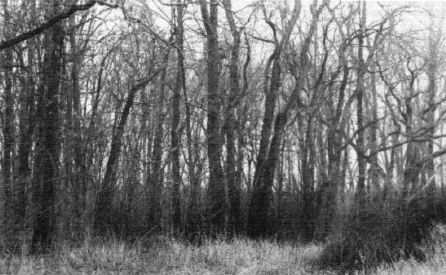
The log roads and skid trails connecting these openings improve access to wildlife and provide access for maintenance. Openings placed on poor sites , including southeast exposures, narrow ridges, poor soils, or frost pockets will last longer and cost less to maintain, but they are less productive. Such openings provide roost cover and singing sites for woodcock; insects for grouse and turkey broods; forage for deer, rabbits and other herbivores; nest sites for songbirds; and seeds for food for many wildlife species.
Insects are a primary food for many young birds including wild turkey and ruffed grouse chicks. Insect production can be 25 times higher in clearings than in adjacent forest undergrowth. Insects can be enhanced by incorporating legumes or forbs in the seed mixture for these sites.
Openings seeded with agronomic forages should be maintained by periodic mowing to control encroachment of woody and unwanted vegetative species. Once a good stand is established, mowing should be kept to a minimum (it may not be required every year) and conducted after the nesting season is complete (August 15). Mowing as early as possible after this date will allow for some regrowth before dormancy, providing some cover during the winter months. Native plant communities can be maintained by mowing after August 15 every one to three years. A mix of agronomic forages and native plant communities on your property will provide high-quality forage early in the growing season and seeds, cover, and forage later in the year.
Cutting timber for firewood is a common practice in uneven-aged management. If cutting firewood is a management objective, either for additional income or for personal use, concentrate firewood cutting to within 25 to 50 feet of the logging road, or within 30 feet of the woodland edge. Small trees or shrubs with wildlife value can remain. This practice creates browse, fruit production, cover, and insect production in the most beneficial locations. At the same time, these practices provide easy access to firewood and require minimal loading time.
Even-aged management ultimately results in a complete overstory removal (regeneration cuts) which creates openings and favors future mast trees for the wildlife species mentioned above. If you do not wish to cut an entire stand, cutting 2 to 10 acre patches every 10 to 20 years periodically increases browse, creates habitat for wildlife species requiring early hardwood successional stages and still provides areas for regeneration of shade intolerant tree species.
Regeneration cuts create areas abundant in herbaceous growth and young woody stems which provide preferred food for deer and most other herbivores (rabbits, voles, and woodchucks). The resulting dense vertical cover provides the needed feeding habitat, protective cover, and nest sites for woodcock, ruffed grouse, yellow-breasted chat, indigo bunting, brown thrasher, blue-winged warbler, and many other species. As these young stands regenerate and begin to mature, they go through a period (25-40 years old) where herbaceous forage, browse, and cover for species like woodcock and grouse are no longer available and hard-mast production has not yet begun. During this period, several required wildlife habitat components are not present in this stand. However, these required components can be provided in adjacent stands. Through proper planning, the landscape as a whole can fulfill all the necessary habitat requirements for wildlife. However, there are a few practices that can be used in regeneration cuts and final shelterwood harvests to increase their wildlife value over the entire life of the stand.
Large forest regeneration openings can be further enhanced for wildlife use by retaining snags and mast producing trees within the opening. Retaining some mast producing trees in this area will increase potential food for wildlife during the first 40 years as the young regenerating trees reach mast production age. Individual trees left in an opening are subject to windthrow, lightning, dieback, and disease. Therefore, leaving trees in small groups or clumps increases the life expectancy of each tree and provides irregular boundaries around the opening. This is needed and most practical in large clearcuts (20-40 acres) that cover an extensive portion (>50%) of the forest. Any live trees which are selected to remain should be sturdy and not susceptible to wind throw, and be capable of responding to increased light (usually 6-12" in diameter with a good crown). Leaving small clumps of trees (two 1/6 acre clumps or one 1/3 acre clump per five acres) on points, rocky ledges, wet areas or inoperable sites, increases harvesting efficiency and creates the least interference with regeneration objectives. These clumps should contain snags, cavity trees, and a mix of hard mast and soft mast trees. Snags are important in regeneration openings. When isolated snags are left, one or two adjacent live trees should be retained with them when possible. Where natural snags are limited, unmerchantable trees can be girdled and left standing, thus reducing operation costs and time.
Generally, the management of 5- to 20-acre irregularly shaped timber stands, some of which are harvested every 10 years over an 80 to 100 year rotation, will result in a mixed timber stand of different ages. The well-dispersed stands of timber in early successional stages will benefit most forest wildlife species (Figure 3). Under the above recommendations, 40% of the timber in commercial production will favor pioneer wildlife species (eg. white-tailed deer, ruffed grouse, blue-winged warbler) by providing stands less than 40 years old on a 100 year rotation. On an 80 year rotation, 50% will be in this cover type.
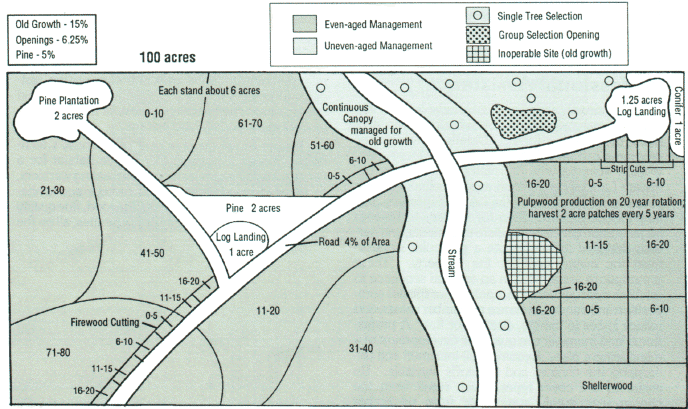
Intense management for early successional wildlife species (eg. American woodcock, ruffed grouse, and chestnut-sided warbler) can be obtained on selected parcels by shortening stand rotations to 20 to 40 years. Small stands of two to five acres should be cut at five year intervals to maintain an even distribution of five year age classes. Maximum interspersion is created when cuts are made in a checkerboard pattern. This type of management fits well with commercial production of hardwood pulpwood, firewood, or specialty products.
Special attention must be paid to areas along streams when conducting even-aged management techniques. A good recommendation for wildlife management is to use single tree selection in wooded areas within 150 to 200 feet of a stream. These areas can be managed for older aged trees and provide a continuous canopy for edge sensitive wildlife species. Group selection and shelterwood cutting may be used to enhance production of shade-intolerant species where providing a continuous canopy is not an objective. Live cavity trees are very important due to the diversity of cavity-using wildlife species in this habitat type. These buffer strips along streams also provide streambank stability, filter sediment from erosion, provide shade and cover for fish and aquatic invertebrates and organic material to drive aquatic food chains. Finally, these areas serve as travel corridors, permitting wildlife to travel from one area of suitable forest cover to another.
Professional assistance is available to help develop a management plan and obtain relevant cost share or incentive funds. Details on assistance programs can be found in FNR-87 "Forestry and Wildlife Management Assistance Available to the Private Landowner," which may be obtained from your county extension office. A management plan may include a prescription for forestry techniques (regeneration cuts, intermediate treatments, and harvest) designed to manipulate a particular stand to meet the overall goal for the property. These prescriptions are applied in an ordered sequence to establish tree regeneration, control tree species composition and density, enhance nontimber values, and reduce losses to insects, disease, or fire. A professional land manager can guide the development of a management plan. Become well-informed and understand the choices and tradeoffs available. Be aware of the cover types which result from the chosen silvicultural system, or from no timber management at all.
Additional measures can be taken to enhance wildlife in a forest which may not enhance timber production (Table 4). Some of these practices may involve input costs. Therefore, the extent to which these are practiced depends on the budget and management objectives of the landowner.
Most of the practices recommended in this publication are general management strategies and will benefit a broad array of wildlife species. To intensify management for a particular wildlife species, contact your Indiana Department of Natural Resources, District Wildlife Biologists for specific recommendations for your property.
Past mass removal of forest tracts left Indiana with extremely fragmented woodlands. Many remaining woodlands have not been managed for long-term objectives such as sustained timber production or wildlife habitat. This deprives landowners of forest-related opportunities. Natural processes have been managing forests for centuries using natural disturbances on a large scale (fire, wind, disease, and insect infestation). Today, people do not allow these natural disturbances to run their intended course. Manipulation of vegetative cover on a smaller and more regular scale than would have occurred naturally permits the landowner and surrounding residents to enjoy a diversity of wildlife, aesthetic, and recreational benefits which otherwise may not have been present during their lifetime.
Proper forest management using today's technology makes it possible to produce habitat for a variety of wildlife species from worm eating warblers, to pileated woodpeckers, wild turkeys and white- tailed deer, while still producing firewood, fine quality hardwoods and recreational opportunities, all on the same parcel of land.
Management practice Comments
---------------------------------------------------------------------------------------
Plant small food plots containing a variety of Provides food where natural supplies are limited or
foods or leave a small portion of adjacent during deep snow and late winter when natural
field crops unharvested. supplies are unaccessible.
Encourage fruit trees - release old existing Provides food where natural supplies are limited or
ones. Plant new ones around edge, in odd during deep snow and late winter when natural
areas, etc. where enough light exists. supplies are unsuccessful.
Plant or encourage shrubs on woodlot edge. Provides cover and nesting habitat as well as food.
Favor trees or shrubs with high wildlife food
value, especially heavy fruit producers like
arrowwood, elderberry, dogwood, hawthorn,
crabapple, and high-bush cranberry.
Erect nest boxes for cavity nesting species This is a good option if retention of a sufficient
(eg. wood duck, squirrel, Northern flicker, number of cavities is inconsistent with timber
barred owl, Northern screech owl, Northern management objectives.
saw-whet owl, raccoon, pileated
woodpecker) where natural dens are
deficient.
Save and encourage beech trees for nut Beech nuts are a preferred food. These trees can
production and den trees. provide two needs at once.
Plant adjacent areas not suited for farming to Prevents soil erosion and provides needed wildlife
trees, shrubs and permanent cover crops. habitat (may also be most efficient use of site).
Establish and maintain openings in or Provides required habitat component for a majority
adjacent to woods. of forest wildlife species.
Plant grass-legume strips along woods' edge. Provides nesting area for ground-nesting species
close to "escape cover."
Cut low wildlife value or cull trees along Provides cover and good mix of vegetation.
woods edge and let lie.
Leave den and potential den trees. Important to many cavity users--bird and mammal.
Leave strip of undisturbed vegetation Water, especially if moving, provides an activity
adjacent to streams, wetlands, ponds, rivers, center for many species.
and lakes.
Protect all wetlands in or near woodlands. Wetlands are the most productive of habitat types.
Plant open or odd areas with conifers in small Provides winter protection as well as roosting and
clumps not to exceed 10 percent of forest nesting cover for many species.
area.
Encourage moderate to dense understory Especially important in attracting songbirds.
throughout portions of the woods,
-----------------------------------------------------------------------------------------------------------
Clark, F. B. and J. G. Hutchinson, Editors, 1989. Central Hardwood Notes. North Central Forest Experiment Station, 1992 Folwell Ave., St. Paul, MN 55108
Hill, D. B., 1987. Small Woodlot Management. Practical Forestry Vol. 1, No. 1. P. 0. Box 482, Lexington, TN 38351
McComb, W. L., 1982. Forestry and Wildlife Habitat Management in Central Hardwoods. Journal of Forestry, Aug., pp. 490-492. Bethesda, MD 20814
Mills, W. L., B. C. Fischer, and T. W. Reisinger, 1987. Upland Hardwood Silviculture: A Review of the Literature. Station Bulletin No. 527. Purdue University, West Lafayette, IN 47907
Negray, K., 1989. A Comfortable Partnership: Wildlife and Forest Management. Practical Forestry Vol. 1, No. 1. P. 0. Box 482, Lexington, TN 38351
FNR-86 The Economics of Timber Stand Improvement
FNR-87 Forestry and Wildlife Management Assistance Available toIndiana Landowners:Providers, Organizations, and Programs
FNR-88 Forestry and Water Quality: Pollution Control Practices
FNR-89 Criteria for Evaluating Forestry Activities in Relation to Water Quality Management
FNR-94 Wildlife Field Notes; The Fox Squirrel and the Gray Squirrel
FNR-95 Wildlife Field Notes: Den Boxes for Squirrels
FNR-96 Wildlife Field Notes: How Vines Provide Wildlife with Food andCover
FNR-97 Wildlife Field Notes: Mast, An Important Wildlife Food Source
FNR-101 Timber Harvesting and Logging Practices for Private Woodlands
FNR-111 Marketing Timber
FNR-125 Managing Forest and Wildlife Resources: An Integrated Approach
FNR-138 Tips on How to Get the Most from Your Timber Harvest
RR 10/94
1 Missouri Department of Conservation and U.S. Forest Service. 1985. Management of Snags and Cavity Trees in Missouri. Habitat Management Series No. 2.
This publication is partially funded by: Indiana Department of Natural Resources, Division of Forestry, through a commitment to Forest Stewardship in Indiana.
Copies of this publication can be obtained from Purdue University Media Distribution Center, 301 South 2nd Street, Lafayette, IN 47905-1232
Cooperative Extension work in Agriculture and Home Economics, state of Indiana, Purdue University, and U.S. Department of Agriculture cooperating; H. A. Wadsworth, Director, West Lafayette, IN. Issued in furtherance of the acts of May 8 and June 30, 1914. The Cooperative Extension Service of Purdue University is an affirmative action/equal opportunity institution.